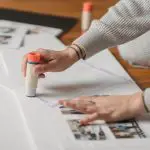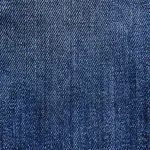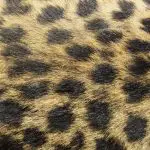Are you looking to add a touch of sophistication to your fabric projects?
In this article, we will guide you through the process of attaching leather to fabric. By following our step-by-step instructions, you can achieve a seamless and durable bond between these two materials.
From choosing the right materials to adding reinforcements for extra strength, we’ve got you covered.
So, grab your leather and fabric and let’s get started!
Table of Contents
Choosing the Right Materials
When attaching leather to fabric, it’s important to choose the right materials. One of the key decisions you’ll need to make is whether to use adhesive or sewing. Let’s discuss the pros and cons of each.
Choosing the right adhesive is crucial when working with leather and fabric. There are various types of adhesives available in the market, such as fabric glue, leather glue, and contact adhesive. Fabric glue is suitable for lightweight fabrics and offers a quick and easy solution. Leather glue, on the other hand, is specifically designed for bonding leather to various materials. Contact adhesive provides a strong and durable bond, but it requires careful application.
Sewing is another method to attach leather to fabric. It offers a traditional and reliable way to join the materials together. Sewing allows for flexibility and easy repair if needed. However, it requires some skill and expertise in handling needles, threads, and sewing machines.
Preparing the Leather and Fabric
Before starting the process, make sure you have prepared the leather and fabric. Proper preparation is crucial for a successful attachment. Here are some steps to follow:
-
Clean the leather and fabric: Remove any dirt, dust, or stains from both materials. Use a mild soap and water solution or a leather cleaner for the leather. For fabric, check the care instructions and follow the recommended cleaning method.
-
Trim the edges: Trim any uneven or frayed edges on both the leather and fabric. This will ensure a neat and professional-looking attachment.
-
Choose the right tools: Use the appropriate tools for attaching leather to fabric. This may include a leather punch, an awl, a leather needle, and a heavy-duty thread. Make sure the tools are in good condition and suitable for the materials you are working with.
Here is a table summarizing the steps to prepare the leather and fabric:
| Step | Action |
|---|---|
| 1 | Clean the materials |
| 2 | Trim the edges |
| 3 | Choose the right tools |
Troubleshooting common issues:
-
Wrinkles or puckering: Ensure that the leather and fabric are evenly aligned and taut before attaching. Smooth out any wrinkles or puckers as you work.
-
Uneven attachment: Apply even pressure when attaching the leather and fabric. Use clips or pins to hold the materials in place while sewing.
Marking and Measuring
After cleaning and trimming, mark and measure the materials to ensure accurate placement and alignment. To achieve a professional finish when attaching leather to fabric, precise measuring techniques are essential.
Start by gathering the necessary tools and equipment, such as a ruler, measuring tape, and fabric marker or chalk. Lay out the leather and fabric on a flat surface, ensuring they are wrinkle-free and smooth. Use the ruler or measuring tape to measure the dimensions required for your project. Take note of any specific measurements needed for pockets, seams, or other design elements.
Mark the measurements directly on the fabric using a fabric marker or chalk, ensuring the marks are visible but not permanent. Double-check your measurements to ensure accuracy before proceeding with the attachment process.
Measuring accurately will help you achieve proper placement and alignment, resulting in a polished and professional finished product. By taking the time to measure carefully, you will ensure that your leather and fabric pieces fit together seamlessly, creating a high-quality and visually appealing end result.
Sewing Techniques for Leather and Fabric
To achieve a polished and professional finish, it’s important to use precise measuring techniques when sewing leather and fabric together. Sewing provides a strong and durable bond compared to gluing, ensuring your project stands the test of time.
When it comes to sewing leather, there are a few important tips to keep in mind. Firstly, use a leather needle specifically designed for sewing through thick materials. This will prevent the needle from breaking and ensure smooth stitching. Additionally, consider using a heavier thread, such as nylon or polyester, to withstand the strain that leather can put on seams.
When sewing leather and fabric together, use clips or binder clips instead of pins to hold the pieces in place. Pins can leave permanent holes in leather, whereas clips provide a secure hold without damaging the material.
Furthermore, consider using a longer stitch length when sewing leather to prevent tearing and ensure the stitches remain intact. Experiment with different stitch lengths to find the most suitable one for your specific project.
Using Adhesives for Attachment
When it comes to using adhesives for attachment, there are a few key points to keep in mind.
First, know the different types of adhesives available, such as fabric glue, hot glue, or spray adhesive, and choose the one that best suits your project.
Secondly, make sure to follow proper application techniques, such as applying the adhesive evenly and allowing it to dry completely.
Lastly, consider the type of fabric you are working with, as certain adhesives may work better on certain fabrics than others.
Types of Adhesives
If you want to attach leather to fabric, you can use different types of adhesives for a secure bond. Here are five types of adhesives that you can consider for your project:
-
Fabric glue: This adhesive is specifically designed for fabric and is easy to use. It provides a strong bond and dries clear.
-
Contact cement: Contact cement is a strong adhesive that is suitable for attaching leather to fabric. It requires applying the adhesive to both surfaces, allowing it to dry, and then pressing them together.
-
Epoxy: Epoxy is a versatile adhesive that can bond various materials, including leather and fabric. It provides a durable and long-lasting bond.
-
Hot glue: Hot glue is a popular adhesive for quick and temporary attachments. It is easy to use, but it may not be suitable for heavy-duty applications.
-
Spray adhesive: Spray adhesive offers a convenient application method and provides a strong bond. It is important to follow the manufacturer’s instructions for proper usage.
When selecting an adhesive, consider factors such as the type of fabric and leather, the required strength of the bond, and the intended use of the attached materials. Proper adhesive selection and application will ensure a secure and long-lasting attachment between leather and fabric.
Proper Application Techniques
For a secure and professional-looking bond, make sure you apply the adhesive evenly on both surfaces.
When attaching leather to fabric, there are several attachment methods you can use, such as sewing, riveting, or using adhesives. Adhesives provide a convenient and effective way to bond leather and fabric together.
To ensure a successful application, start by preparing both surfaces. Clean them thoroughly and remove any dirt or residue.
Next, apply the adhesive evenly on both the leather and fabric. Use a brush or a spreader to achieve a smooth and uniform coat.
Press the surfaces firmly together and hold them in place for the recommended drying time.
If you encounter any issues, such as uneven bonding or lifting edges, troubleshoot by reapplying the adhesive or using additional attachment methods like sewing or riveting.
Considerations for Fabric Type
One important consideration is the type of fabric you are working with when attaching leather. Different fabrics have different properties and may require different bonding techniques to ensure a secure and long-lasting attachment. To help you understand the fabric compatibility and suitable leather bonding techniques, here is a table with some common fabric types and their recommended bonding methods:
| Fabric Type | Bonding Technique |
|---|---|
| Cotton | Adhesive |
| Denim | Sewing |
| Silk | Glue |
| Polyester | Heat Bonding |
| Wool | Stitching |
Adding Reinforcements for Durability
When it comes to adding reinforcements for durability, you may be wondering whether sewing or adhesive is the better option.
In this discussion, we will explore the pros and cons of both techniques, as well as the best reinforcement techniques to ensure long-lasting results.
Sewing Vs. Adhesive?
Sewing leather to fabric can be more durable than using adhesive. When it comes to attaching leather to fabric, sewing techniques offer a stronger and longer-lasting bond. Here’s why:
-
Needle and thread: The act of sewing creates a series of interlocking stitches that securely hold the leather and fabric together.
-
Tight and secure: Sewing allows for a tight and secure connection between the leather and fabric, ensuring that they stay in place even with regular use.
-
Flexibility and strength: The flexibility of the thread combined with the strength of the needle allows the leather and fabric to move and stretch without compromising the bond.
While adhesive selection plays a role in the durability of the attachment, sewing remains the preferred method for its reliability and strength.
So next time you’re attaching leather to fabric, consider using a needle and thread for a more durable outcome.
Best Reinforcement Techniques?
To reinforce your materials effectively, make sure to explore different stitching techniques.
There are several reinforcement types commonly used when attaching leather to fabric. One method is using a basic running stitch, which involves passing the needle through both materials continuously. This technique is simple and quick, but it may not provide the strongest bond.
Another option is the whipstitch, where the needle goes through the edge of the fabric and leather in a crisscross pattern. This technique offers more durability but can be time-consuming.
Additionally, you can use a backstitch, which involves sewing two stitches forward and one stitch back. This technique provides a secure and professional-looking finish.
Ultimately, the choice of reinforcement technique depends on your desired strength and aesthetic.
Finishing Touches and Trimming
You can add some stylish finishing touches and trimming to your leather and fabric project.
When it comes to trimming techniques, there are several options to consider. One popular method is using decorative accents such as braids, ribbons, or piping. These can be sewn along the edges of your project to add a touch of elegance and give it a polished look.
Another technique is using leather or fabric strips to create a border or outline around the edges. This can be done by sewing the strips directly onto the project or by attaching them with adhesive.
Additionally, you can experiment with different stitching patterns to create unique and eye-catching designs. For example, a simple running stitch along the edges can add a subtle detail, while a decorative topstitch can make a bold statement.
When choosing the right trimming technique, consider the overall style and purpose of your project. Whether you want to add a pop of color or enhance the texture, these finishing touches can elevate your leather and fabric project to the next level.
Care and Maintenance of Leather-Fabric Attachments
When caring for your leather-fabric attachments, it’s essential to regularly clean and condition them to maintain their durability and appearance. Leather is a natural material that requires proper care to retain its strength and flexibility.
Here are some leather fabric attachment techniques and troubleshooting common issues to help you keep your attachments in top condition:
-
Clean regularly: Use a soft cloth or brush to remove dust and dirt from your leather-fabric attachments. Avoid using harsh chemicals or abrasive cleaners, as they can damage the leather.
-
Condition the leather: Apply a leather conditioner to keep the leather moisturized and prevent it from drying out or cracking. Be sure to follow the manufacturer’s instructions for the specific conditioner you are using.
-
Protect from moisture: Leather is susceptible to water damage, so it’s important to protect your attachments from getting wet. If they do get wet, allow them to dry naturally and avoid using heat sources, as they can cause the leather to shrink or crack.
-
Address stains promptly: If your leather-fabric attachments get stained, blot the stain gently with a clean, damp cloth. Avoid rubbing the stain, as it can spread the stain further. If the stain persists, seek professional help for cleaning.
Conclusion
In conclusion, attaching leather to fabric requires careful preparation and the right materials. By marking and measuring accurately, using appropriate sewing techniques, and considering adhesives and reinforcements, you can create a durable attachment.
Remember to finish the edges neatly and regularly maintain your leather-fabric creations for longevity. With these steps, you can successfully combine leather and fabric to create beautiful and functional pieces.
- Medical Textiles: Advancements in Antimicrobial Fabrics - July 24, 2024
- Protective Clothing: Fire-Resistant Fabric Solutions - July 24, 2024
- Extreme Sports: The Importance of Performance Fabrics - July 24, 2024







